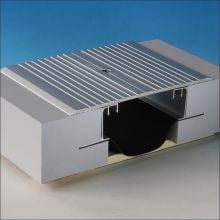Steel expansion joints are commonly called by the somewhat deceptive name of steel bellows, as expansion joints are totally unlike the old natural leather bellows that were utilized to pump air right into a fireplace, furnace, or kiln. The resemblance shared between steel below and the natural leather variety is only slight, in that they are both sealed chambers that broaden as well as contract along concertinaed folds up in the sides. While the term “steel bellows” may be utilized mutually with Building Floor Expansion Joint Cover, bellows are generally booked for referral to a vessel, bladder, or uneven shape that falls when it clears, while expansion joints are made use of as a junction in a pipeline.
Steel expansion joints are a concertinaed in-line joint pieces consisted of several liquids and also high-pressure gas pipeline systems for a variety of factors. When most pipes are developed, it is not uncommon for there to be areas where 2 pipeline sections do not satisfy completely. An expansion joint enables some shear, an imprecise space, or a mild contour at a junction, or simply put, lateral, axial, and also angular movement is allowed to take place at the sign up with. Any significant twisting of the line at an expansion joint will create the bellows to fall short, and also minor torsion on a metal expansion joint will drastically reduce its effectiveness.
Bonded metal bellows have several applications in medicine, hefty sector, defense, air travel, and also aerospace. They are often used in interior medical implants, fluid sensing units, actuators, altitude sensing units, pressure surge arrestors, and also for waste fluid storage. Their retractable layout makes them ideal for applications where the room is crucial, such as on the space shuttles and also International Spaceport station.
Expansion joints are created to restrict vibration, noise, activity from warm expansion as well as contraction, and stress waviness (a usual example is “water-hammer” in the pipes of an old residence) in pressurized lines. Proper setup of expansion joints permits you to take care of where any kind of movement in the system occurs, stopping damages or movement to the rest of the system forcibly it to take place at the sign up with.
Metal expansion joints can be needed to run under extremely extreme conditions particularly when deployed in central heating boiler seals or airplane, from temperatures varying between -200 ° C(less than -300 ° F)and also 1300 ° C (2500 ° F), as well as at stress varying between the near overall vacuum of the area to over 2000 pounds, and the precision needed of this tools requires rigorous screening before release in numerous systems. Building Expansion Joint Manufacturers manufacture high quality expansion joints to fulfil your requirements.
To avoid undue strains being positioned on expansion joints, makers have developed several different support structures that can be released on a pipeline increasing the effectiveness of the provided bellows. Some bellows are fitted with interior linings or external sheaths to avoid damages to the main assembly, as well as outside tie-rods or a universal joint called gimbals is suited for some applications to stop twisting, or too much motion in any instructions beyond design restrictions.
As metal expansion signs up are commonly released in extremely important applications, extensive Quality Assurance (QA) screening is typically called for of each private device after manufacture before it is deployed. Manufacturing shops might subject a finished device to radiography, ultrasound, mass spectrometry, magnetic, hydrostatic, helium leakage, and also fluid penetration screening to assure that the system does not have any negative anomalies or tiny leakages. It is also feasible to check the solidity, impact resistance, pressure limitation, as well as favorable composition of a completed product.


